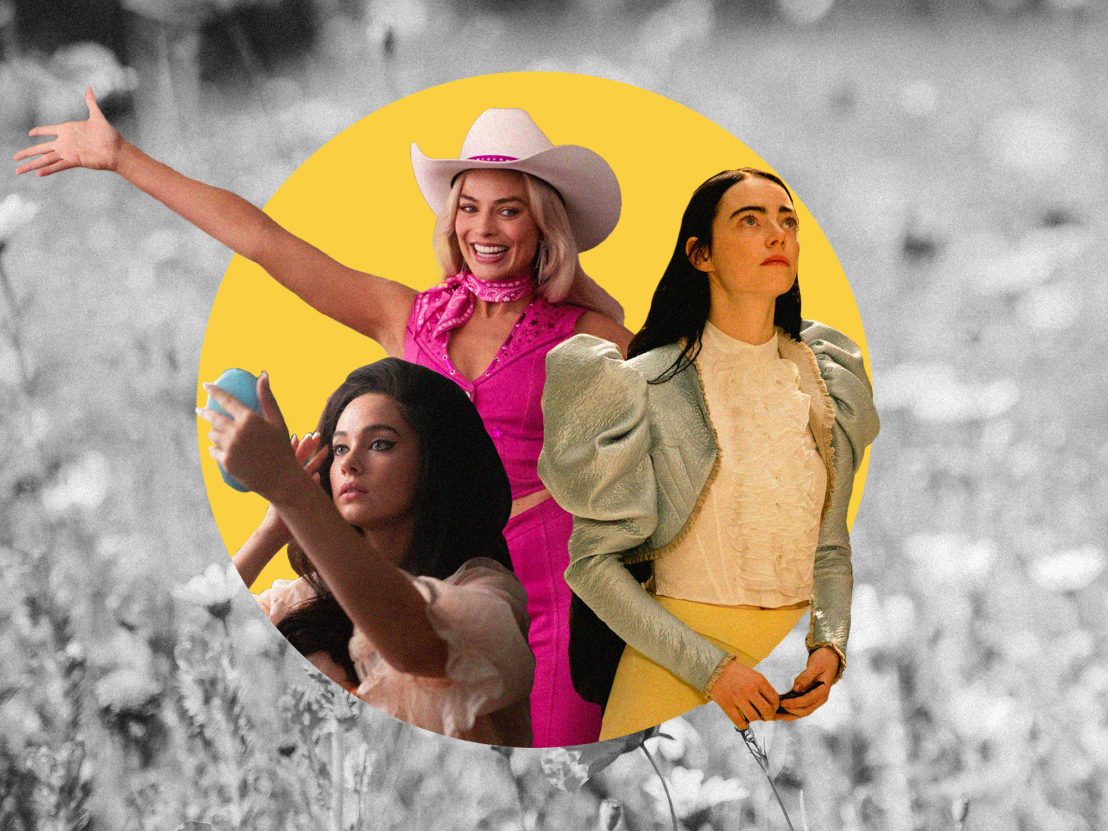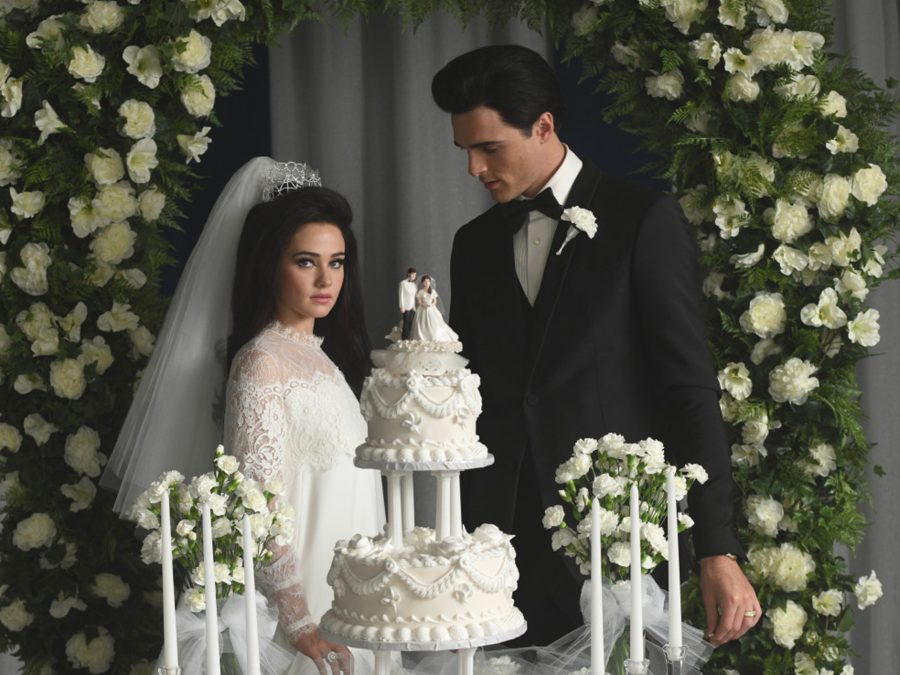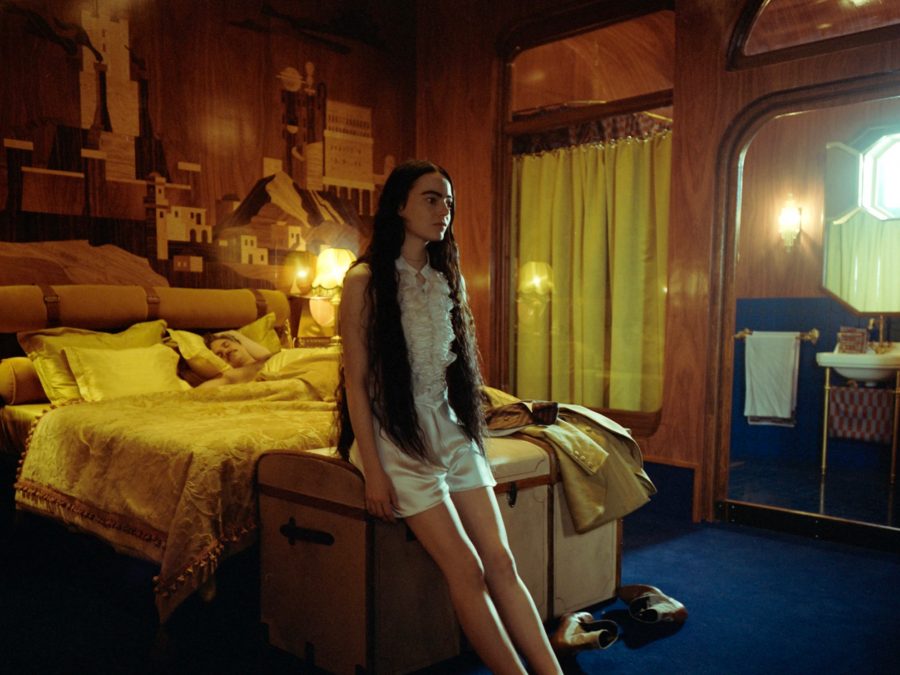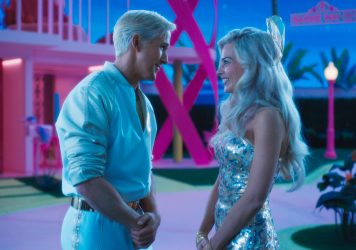
There she is: her blonde hair swaying in the breeze as she turns – in slow motion naturally – to glance at you over her shoulder, hazy sunlight dancing across her serene face. And there is her bedroom, filled with those mysterious emblems of girlhood: a hairbrush, a ribbon, a tube of lipstick, a flash of frills, a stack of records, a poster of some pop star. There is nothing, it seems, quite so fascinating as a girl on screen.
You’ve seen these images before – maybe at the cinema, or perhaps in a carefully curated selection of aesthetic film stills on Twitter or Pinterest. It could have even been a decade ago when images from films such as The Virgin Suicides, Marie Antoinette, and Lolita filled our Tumblr feeds.
Culturally, girlhood ‘lore’ goes back a long way – yes, even further back than the days of Tumblr. As Claire Marie Healy, founder of research studio Girlhood Studies, notes in her new book on the subject, portraits of young girls line the halls of every art gallery – Sir John Everett Millais’s portrait of Ophelia is a particularly influential example of how a long tradition of art history shapes our current cultural understanding of what girlhood looks like. More recently, films by directors including Sofia Coppola and Greta Gerwig have added to our shared visual lexicon of girlhood imagery.
But this year, it seems our cultural enquiry into the nature of being a girl has reached a new high. Social media’s insatiable obsession with the aesthetics of girlhood rages on in the form of microtrends created largely by and for an audience of Gen Z and Millennial young women across Instagram and TikTok. Since the emergence of the ‘Hot Girl Summer’ trend in 2019 thanks to Megan Thee Stallion’s song of the same name, we’ve seen feral girl summer, hot girl walks, strawberry girl, tomato girl, girl math, girl dinner, snail girls, lazy girl jobs and countless others popping up on our feeds.
This coincides with Taylor Swift’s ongoing re-recording project that sees her revisiting the albums she recorded in her teens and early twenties, alongside the rise of young female singers including Olivia Rodrigo and Maisie Peters whose music serves as an exploration of the state of girlhood.
Meanwhile, for girls in the real world, the social and political landscape feels increasingly ominous and violent. From a broad cultural perspective, influencers like Andrew Tate and Myron Gaines spread a message of toxic masculinity that encourages misogyny as well as the hypersexualisation of teen girls. Incel culture is on the rise, and the headlines are filled with horror stories. Earlier this year in London, a teenage girl was stabbed to death in Croydon defending a friend who was allegedly attacked after refusing a bouquet of flowers from a male classmate. An ex-police officer was recently charged with coercing hundreds of young girls into sending him explicit images. In the recent accusations of rape and sexual abuse leveled at Russell Brand, a woman who was just 16 at the time claimed the comedian called her his “little dolly”. A 2017 study showed that a fifth of teenage girls in the UK have experienced domestic abuse in a romantic relationship.
This turbulent cultural landscape – one that sees us embracing heightened girlhood aesthetics previously dismissed as frivolous while simultaneously confronting deeply unsettling cultural waves of misogyny – is the context in which a new batch of girlhood films reaches our screens.
The coming-of-age story that follows a girl on her path to adulthood is nothing new – in fact, it has a long tradition in storytelling. Kelly Fremon Craig’s 2023 comedy Are You There God? It’s Me, Margaret is a fairly straight adaptation of Judy Blume’s iconic 1970s tale of tweendom in suburban America. Margaret, the eleven-year-old heroine of the story, is desperate to reach womanhood and everything it entails – or at least everything she thinks it entails – boyfriends, nice clothes, make-up, breasts, and, of course, periods. In many ways, the novel set the standard for the female coming-of-narrative story by capturing the awkwardness and yearning that comes with growing up into a woman, with its influence extending to Sammi Cohen’s recent pre-teen comedy You Are So Not Invited To My Bat Mitzvah (also adapted into a film from a YA novel).
Sofia Coppola is no stranger to the subject of girlhood, with her films frequently cited as key texts. Her latest, Priscilla, turns the lens on Elvis and Priscilla Presley, one of pop culture’s most iconic couples, offering up Priscilla’s perspective on events. It is also a coming-of-age tale – Coppola’s film ventures into the darker side of girlhood, exploring not only how it feels to be a girl yearning for imagined womanhood, but how men are prone to project womanhood onto them prematurely.
Priscilla’s grand fantasies about life as a glamorous girlfriend of the biggest pop star in the world are – for anyone who has ever been a teenage girl – intensely relatable. She plays his records, cuts out his pictures from magazines and doodles his name in her notebooks. This innocent fantasising is a rite of passage for every teen, but when Priscilla begins a relationship with Elvis and moves to Graceland, she discovers that the fairytale romance she had imagined doesn’t exist. Instead, Elvis proves to be controlling and emotionally abusive.

A number of other films delve into this darkness through a more contemporary lens, capturing the implicit danger of being a girl in a world where being objectified, dismissed and hypersexualised by men is the norm. Molly Manning Walker’s feature debut, How To Have Sex, sets the scene in Malia where three 16-year-old girls are on a hedonistic teen vacation, while Kitty Green’s The Royal Hotel sees two Canadian girls take up bar work in a remote, male-dominated mining town on the Australian outback. Finally, based on the viral New Yorker short story of the same name, Susanna Fogel’s Cat Person plays with genre to depict the confusion and paranoia of sex and dating as a heterosexual young woman today.
Similarly to Priscilla, the teen capacity for fantasy is once again explored in How To How Sex. Female lead Tara imagines a picture-perfect holiday romance, only to find herself in increasingly dangerous situations which ultimately result in tragedy. In The Royal Hotel, what begin as ominous misogynistic undertones and microaggressions from bar patrons ultimately develop into outright expressions of sexual violence against the girls.
While Priscilla’s fantasy life consists of wild daydreams about her pop star boyfriend, in the contemporary Cat Person, the 20-year-old Margot’s fantasy life is filled with images inspired by the films she’s seen and the headlines in the news. At one moment, she sees a flash of her new boyfriend as the perfect man – a tall, dark and handsome rom-com lead. The next moment, she imagines the graphic image of a girl in chains behind a closed door in his flat. Ultimately, he is neither a serial killer nor a romantic hero – just a bad kisser and a bit of a loser.
Violence is by no means a new trope in movies centred on teenage girls. The likes of Heathers, Mean Girls, Jawbreaker and, more recently Netflix’s Do Revenge dare to paint teen girls as harsher, crueller, stranger beings than culture traditionally allowed them to be. This year Emma Seligman’s Bottoms followed in this tradition, set in an American high school where two queer girls start a fight club as a ruse to hook up with hot cheerleaders.
According to Healy, this new trend of darker female-led films is a natural response to the past few decades. “There is a recent history of so much sexualization of teenage girls… and there is a wave of filmmaking, especially from women filmmakers who grew up in the 90s or the naughties [that explores] this hyper-sexualization,” says Healy. “I do think that it is a reaction to growing up with quite shallow content around girlhood, where 28-year-olds are playing 15-year-olds. And it doesn’t surprise me that there is this interest in this because we’re always trying to figure out about ourselves.”
On the whole, films this year are interested not only in presenting the image of girlhood that we already know but in giving a truly feminine perspective – one from within the state of girlhood itself. Perhaps this is why there is another ‘type’ of girlhood film emerging this year – the type that offers a more experimental, meta-exploration of girlhood altogether.
In Barbie, the biggest film of the year, Greta Gerwig takes on the doll that became synonymous with girlhood for generations of young women with a uniquely postmodern self-awareness, giving the ‘ideal woman’ her own coming-of-age journey. In Yorgos Lanthimos’s Poor Things, based on the 1992 novel by Alasdair Gray, a Frankenstein-like experiment sees a dead woman, Bella, re-awakened in her adult body with her own unborn baby’s brain implanted in her head. What happens when a girl grows up in an adult body?
Like Barbie, Poor Things turns the coming-of-age genre on its head, placing girlish naivety within an adult body to simplify the exploration not only of how girls view the world, but also of how the world views them in return – after all, when a girl grows up unaware of the hypersexualization, the expectations, and all the other things women are told from a young age they should care about, they are effectively a blank slate, and when others view them, they aren’t trained to perform girlishness in the same way that ‘real’ girls all do without thinking.
But while the current crop of films may have a darkness that draws from the realities of real-world girlhood, they don’t neglect the aesthetic, emotional pleasures of being a girl either, and it’s no surprise they are often in direct conversation with this previously established history of girlhood imagery. They make use of familiar images and objects to place themselves immediately within a very specific aesthetic context – and comment on the iterations of girlhood that came before.
According to Healy, famous images of girlhood – like Kirsten Dunst lying in the field from The Virgin Suicides or Sue Lyon as Lolita in her heart-shaped sunglasses – have taken on a life of their own thanks to our layered associations with them. Not only have these images become instantly recognisable thanks to their proliferation online, they have also been used over and over again in pop culture. Just take Marc Jacobs’ infamous Daisy ad or Lana Del Rey’s many references to Lolita (and her glasses) over the years.
“I think there’s a tendency in cultural criticism, not often by young women, to reduce [this genre] – to see an interest in such things as somehow reductive or maybe un-feminist or just purely nostalgic,” says Healy. “For me, I think it’s really productive to think about girlhood more in terms of, yes, personal experiences and memories, but also this bank of images and film – this visual culture that we have.”

Certain objects have also been handed down throughout the years, taking on layers of meaning – usually the objects found in a girl’s private space, such as lipstick, hairspray, ribbons or lace. Healy notes a column she recently wrote on ballet shoes. “When you then start to think about objects, it’s another way of sifting through and figuring out ideas of girlhood,” she says. “These objects are associated with these shared ideas of girlhood and can be very charged and potent. They have this kind of powerful charge and I think that’s something that Coppola knows quite intimately and utilises in all her films in a wonderful way.”
Priscilla opens with a montage of her getting ready – hairspray, fluffy rug, pedicure, and so on – Coppola is, as Healy suggests, not only referencing the cultural history, but her own artistic history, too. But other films draw from this cultural bank of imagery and experience, too. In How To Have Sex, Tara wears an ‘angel’ necklace and agonises over her eyebrow pencil application. In Poor Things, Bella’s wardrobe is filled with puffed sleeves, lace trimmings and, bizarrely, wonderfully, completely anachronistic mini skirts. Barbie is stuffed with costumes and sets inspired by Mattel’s products, all of which are in themselves pieces of girlhood iconography.
On one hand, these images and objects serve to remind us of the girls’ youth. On the other hand, their instant recognizability reminds us of that magical feeling of being a girl – after all, it’s not completely awful. In fact, it’s a time filled with soaring emotions and boundless creativity. These charged images create a visceral emotional tie to that brief in-between stage of a woman’s life.
Healy recalls that she herself reached a creative peak in her teen years. “I do think there is this kind of creative charge to coming of age. [When you get older], life’s reality kind of changes things,” she says. “I do think that can be what people respond to in [my] work. And I do think it is what people respond to in some of these movies that you’re talking about.”
Like Healy, who is consistently drawn back to her own girlhood, the films mentioned here are all helmed by female directors who, it seems, share the same impulse to look back – to enquire into not only what made the period of girlhood so special, but also how the world, with all of its ingrained sexism and potential for danger, threatens to rip that time away.
Perhaps this is where the rise of the online ‘girl’ trend comes from too. Perhaps the same impulse that drives female filmmakers to return to the period of girlhood is driving women to explore their complex relationship to girlhood through online trends.
“I have seen a lot of stuff out there which sees [these trends] as a regressive thing – as some kind of self-infantilization,” Healy says. “But I think it’s never a case of pure nostalgia or pure regression – what you’ve got is a generation that has grown up with the Internet. They’ve grown up with references. It’s more a case of referencing this shared world of images and ideas and taking a certain aesthetic pleasure in these things.”
In her book, Healy suggests that the latest movement in visual art features the girl evolving from merely the subject of the art into both subject and artist at once. She steps behind the easel or the camera to paint or film her own self-portrait. She reclaims control of the gaze. It is a new way to capture the complexity of girlhood in all of its elation, fear and confusion.
This year, female filmmakers have, in their own way, done just this – they have gotten behind the camera and ventured backwards to excavate their own adult relationships with girlhood – girlhood, which, as adult women know, is both a very real experience and something that is projected onto you.
It is a uniquely heightened time for young women. The world feels more violent and dangerous than ever. The new generation of filmmakers are, it seems, acutely aware of the worryingly regressive waves of misogyny within society. As such, they confront their audiences with what often feels like a first-person exploration of girlhood as it is today. Girlhood is, they seem to say, a time of awakening not only to oneself but also to the often disappointing and sometimes outright horrifying realities of the world.
But, in the face of all of this, women in the real world are embracing the aesthetic joys associated with girlhood with a certain sense of defiance. On-screen, the same defiant self-awareness rings out. By getting behind the camera and looking back toward their own experiences of girlhood, female filmmakers and creatives are embracing the long history of girlhood aesthetics – indeed, they are reclaiming these images as their own. Ultimately, their heroines are not merely victims. And the imagery associated with girlhood – pink accessories, painted nails, lace and ribbons – are not signs of weakness or naivety, but of strength and artistry.
On the surface, each of these films takes us on the same old coming-of-age journey – from innocence to knowledge; from girlhood to womanhood. They put the girl’s experience at the forefront, diving into the minute details of their perceptions, they each give their young heroines the agency and perspective that, throughout the history of girlhood in art, has so rarely been afforded. The path to womanhood has become more fraught, and more confusing than ever – but, ultimately, there is joy and magic and, most importantly, real strength to be found within it.
Published 1 Nov 2023

Greta Gerwig's behemoth blockbuster is a stranger, more fascinating film than its hyper-corporate marketing would suggest.

Yorgos Lanthimos reunites with his Emma Stone for a lavish and lewd romp through a steampunk vision of Europe.

Sofia Coppola turns her keen eye to modern mythology, adapting Priscilla Presley's memoir into a gorgeous, acutely sad coming-of-age drama.